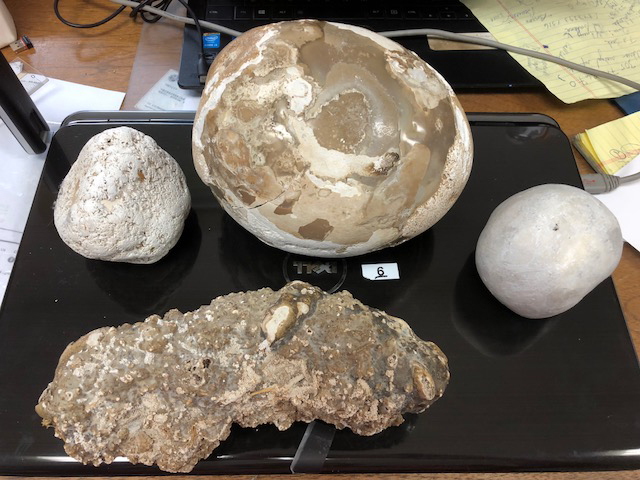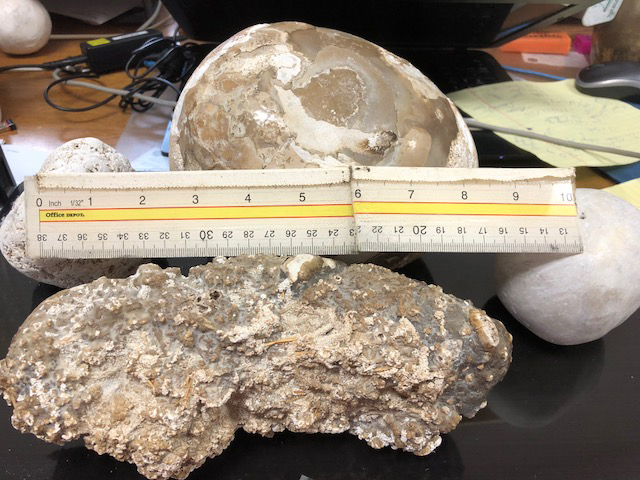Byron Reid, VMD
Equine colic (abdominal pain) is very stressful for horse owners and caregivers and can be caused by dozens, even hundreds of different reasons. One somewhat bizarre source of colic pain is that caused by stone-like concretions of mineral that form within the equine colon and are known as enteroliths.
Enteroliths, sometimes referred to as stones, are layered substances of calcium compounds that form around trapped debris, such as sand, pebbles, wood chips, twine or other foreign objects that a horse eats but doesn’t digest. The stones begin as tiny firm particles and slowly grow as layers are deposited around them. Sometimes they form as single structures and sometimes multiple similar objects share a colon.

Enteroliths grow over time and if small enough are occasionally passed unnoticed in the horse’s manure. If they reach a large enough size (about baseball/softball size) they become too large to be passed and sometimes become lodged in the small colon, resulting in a total intestinal obstruction.
Because of the wide variety of sizes and numbers of enteroliths, they can result in a variety of presenting signs. Some horses have enteroliths for years and they cause no observed signs of colic at all. Some are associated with multiple or occasional bouts of mild to moderate colic, while some stones can reach unbelievably large sizes with variably severe signs of pain. However, the upper limit of size for these stones is the size of the colon. The largest diameter of the equine large colon is only about 20 centimeters (eight inches). So, while some of these stone-like structures might be longer than eight inches, their largest diameter in one dimension is usually not much more than that.
Enteroliths occasionally cause moderately severe colic but rarely is colic as violent as we associate with large colon volvulus (twist) or small intestinal obstruction/strangulation. One typical history for very large stones is intermittent obstruction associated with moderate but transient signs. We think this occurs when the large stone is acting like a ball valve in the area where the colon narrows into a funnel-shape where the right dorsal colon (20-some centimeters wide) narrows into the transverse and small colon (eight to ten centimeters wide). Another common presentation is when a hardball-sized enterolith passes into the small colon and becomes tightly wedged and completely obstructs the intestine. Typically these horses are colicky but only moderately so and pain is relatively easily controlled, yet gas is trapped and bloat often reaches huge proportions. Sometimes these bloated individuals come to the hospital after several days of medical treatment with almost no manure having been passed for days.
Enteroliths, once suspected or discovered at exploratory surgery are best treated by surgical removal from the intestine. Usually an incision must be made in the colon, either the large or the small colon, just large enough to allow the enterolith to be removed. The incision is then closed with suture and the surgery is completed.
Fortunately, enterolith surgery is one of the most successful types of colic surgery that we do. The reason is that the blood supply is often spared, making it possible to save these horses even after several hours or even days of colic. A few exceptions stand out in our minds as our lost equine patients make a very large and sad impression. One is when founder occurs because of toxins absorbed from the injured intestine. These horses sometimes show signs of laminitis just as they are recovering from the colic. Another situation is when a stone is lodged in the small colon for several days and causes pressure necrosis to the portion of the organ furthest away from the blood supply. When this occurs in an area that cannot be seen because it is attached too closely to the dorsal body wall, it can go unrecognized and will cause unexpected problems in the recovery period. Yet one other rare cause of failure is when the stone causes intestinal rupture before surgery can be performed and massive fecal contamination of the abdomen occurs.
This disease is one of the most well reported of any disease of horses. Veterinary journal reports exist where nearly 1000 affected and operated horses are included. The most critical information found for the development of equine enterolith formation is the very important and consistent risk factor of feeding alfalfa hay. While that is not to say the feeding of alfalfa is to be avoided in all situations, but feeding alfalfa hay, especially exclusively alfalfa hay, turns out to be a consistent risk factor in nearly all veterinary journal reports.

